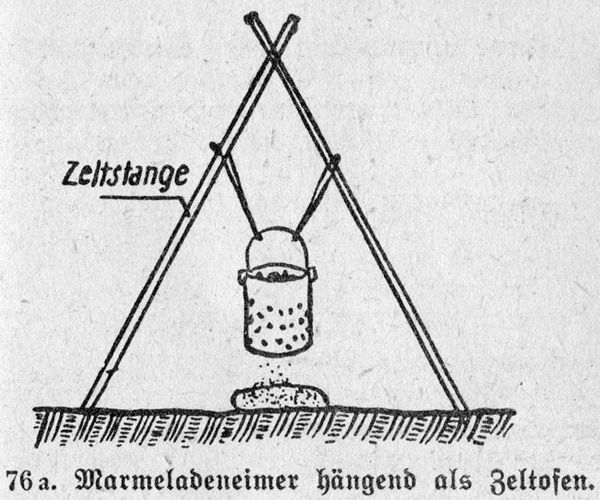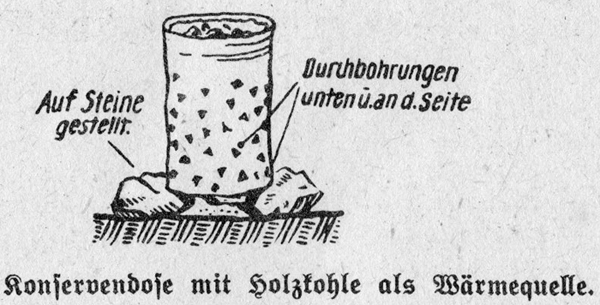How to make a tin-can tent oven to keep warm.
The winter of 1941-42 was disastrous for German forces serving on the Eastern Front. The Wehrmacht was ill-prepared for the bitter cold temperatures of the Russian battlefields. In the battle for Moscow, there were more casualties from cold than from combat. About 250,000 German soldiers suffered frostbite in that freezing winter. As part of a plan to prevent a repeat disaster the following winter, in 1942 the Wehrmacht issued a handy little book called “Taschenbuch fuer den Winterkrieg” (Paperback for the winter war) which featured extensive information about winter camouflage, clothing for keeping warm, maintenance of equipment in low temperatures and other subjects designed to help German soldiers live and fight in the Russian winter. The following excerpt from this manual discusses ideas for improvised heat sources. 1. The ability of the soldier to resist the cold is considerably strengthened when as many as possible opportunities to get warm or to stay warm can be achieved, especially for the feet of sentries. Even field positions, bivouacs and emergency lodging can be sufficiently heated with simple equipment or self-made devices. Even a stopgap heater is better than none at all. The following can serve for warmth: -Candles -Lamps -Cooking equipment (alcohol, benzene, petroleum) -Warming fires -Hot stones, etc. -Field ovens -Lodging ovens -Walled-up ovens 2. Tents, snow bivouacs, etc. can readily be heated with candles, lamps or cooking equipment to a somewhat tolerable temperature. Food cans or marmalade buckets poked through with holes and filled with glowing ashes or wood coals also provide a good, handy heat source. Development of harmful gases must be looked out for (pay close attention to the regulations!). Through covering, the melting of snow over the candle etc. can be hindered.” The text is accompanied by two illustrations that show these improvised tin-can heaters. The first shows a tent oven made from a marmalade bucket. The bucket has holes poked into the sides and is suspended from tent poles. The second illustration shows how to use a food can with wood coals as a heat source. The can is placed on stones and has many holes poked in the sides and bottom. It is likely that these ideas were inspired by similar improvised devices used by peasant farmers in rural parts of the Eastern areas occupied by German soldiers. Novelist Jerzy Kosiński was born in Poland in 1933 and survived the German occupation with help from local villagers. His 1965 novel “The Painted Bird” is a fanciful account of a small boy wandering the Polish countryside during the war that draws on Kosiński’s own childhood experiences. In the novel, Kosiński describes rural farmers and workers using a device he calls a “Comet,” which consisted of “a one-quart preserve can, open at one end and with a lot of small nail holes punched in the sides. A three-foot loop of wire was hooked to the top of the can by way of a handle, so that one could swing it… Such a small portable stove could serve as a constant source of heat and as a miniature kitchen.” Kosiński writes that “any kind of fuel available” was used including peat, damp leaves and moss, dry twigs, hay and potato stalks. “People always carried small sacks on their backs or at their belts for collecting fuel for the comets. In the daytime, peasants working in the fields baked vegetables, birds and fish in them.” It is easy to see how this useful little stove could have had myriad applications in the field. It seems likely that many soldiers found time to create such improvised heaters. Wehrmacht food cans came in various sizes, from small cans perhaps used for individual rations to large cans used for bulk food prepared in field kitchens. These little stoves could have kept fortunate soldiers reasonably warm even in the bitter cold.
